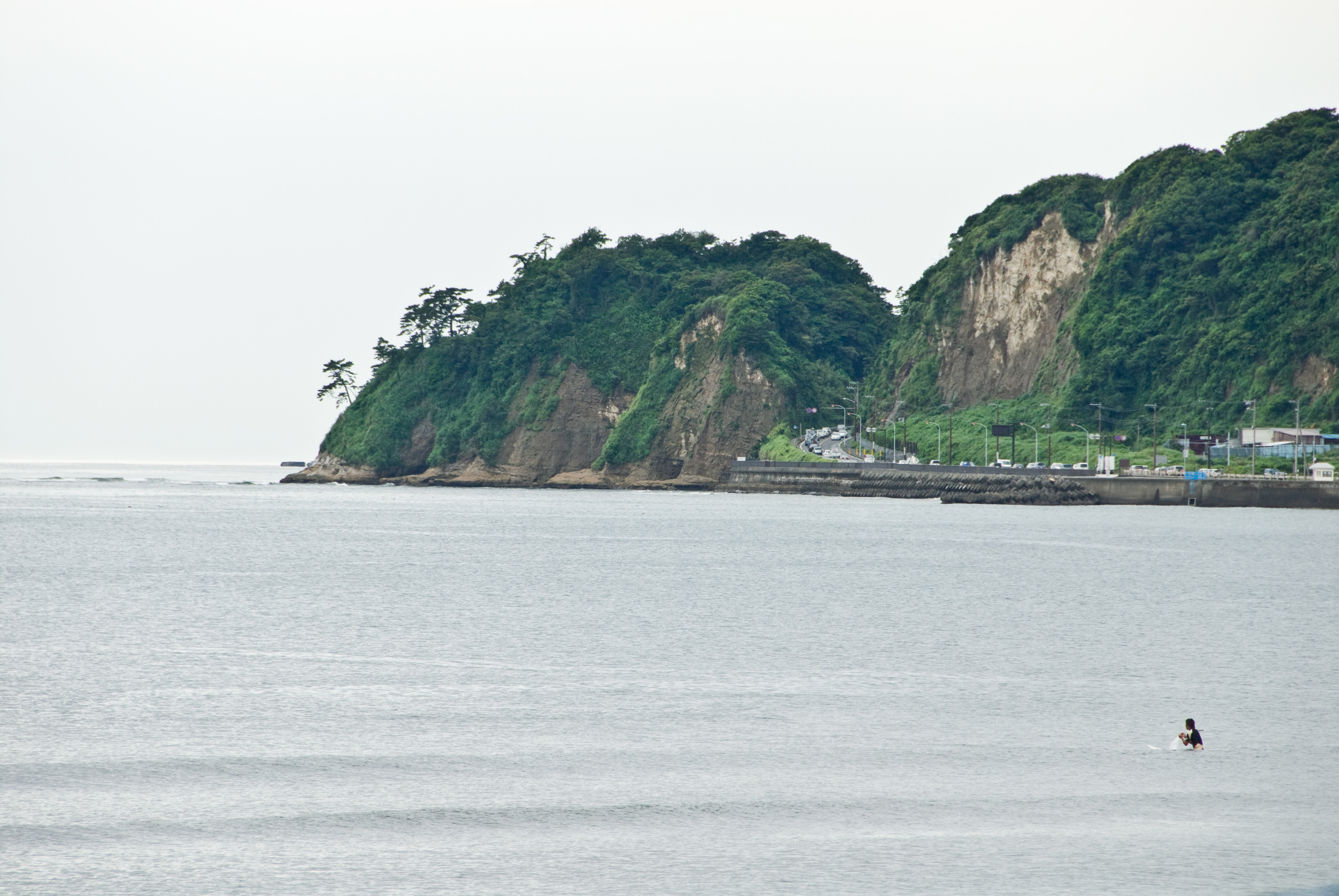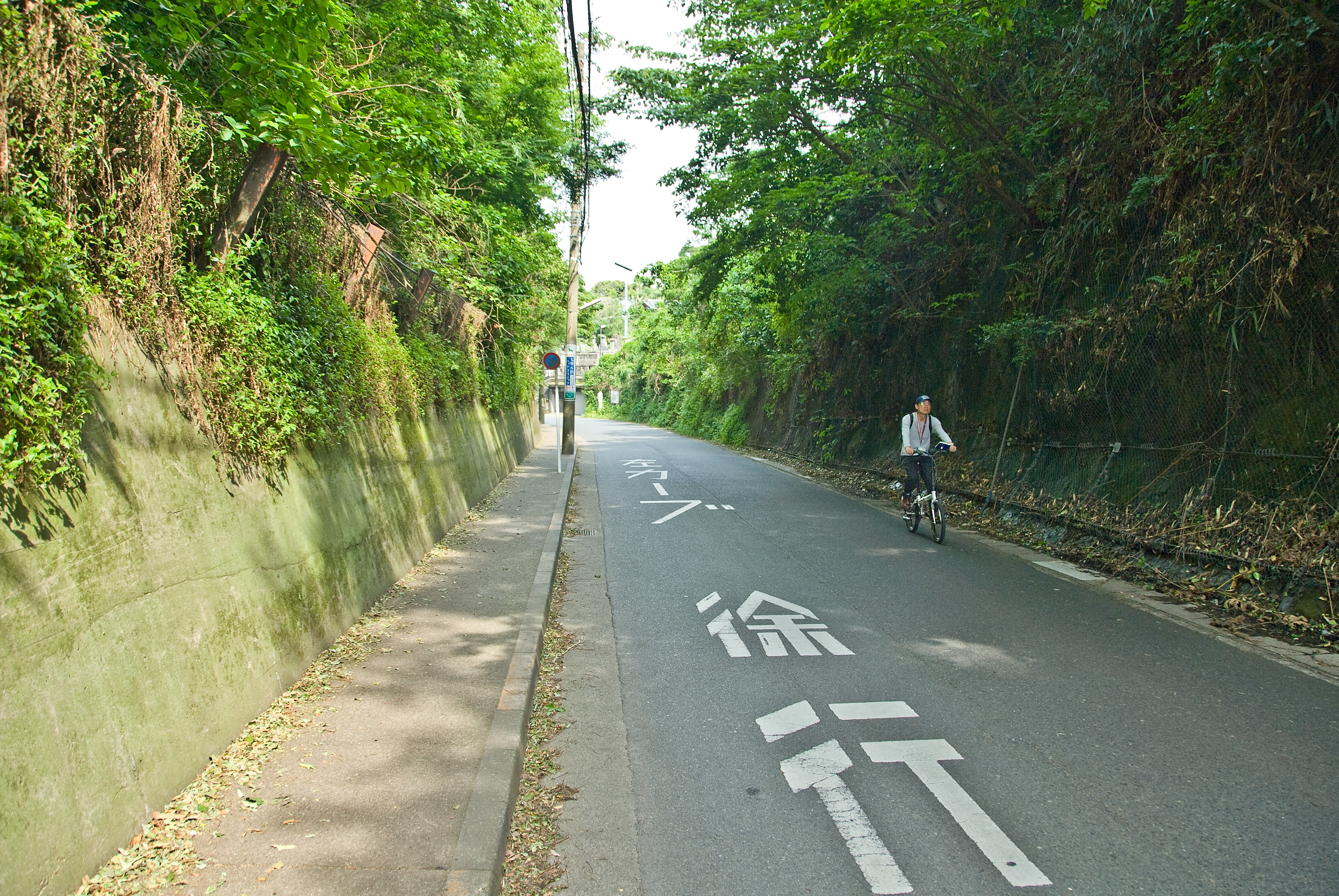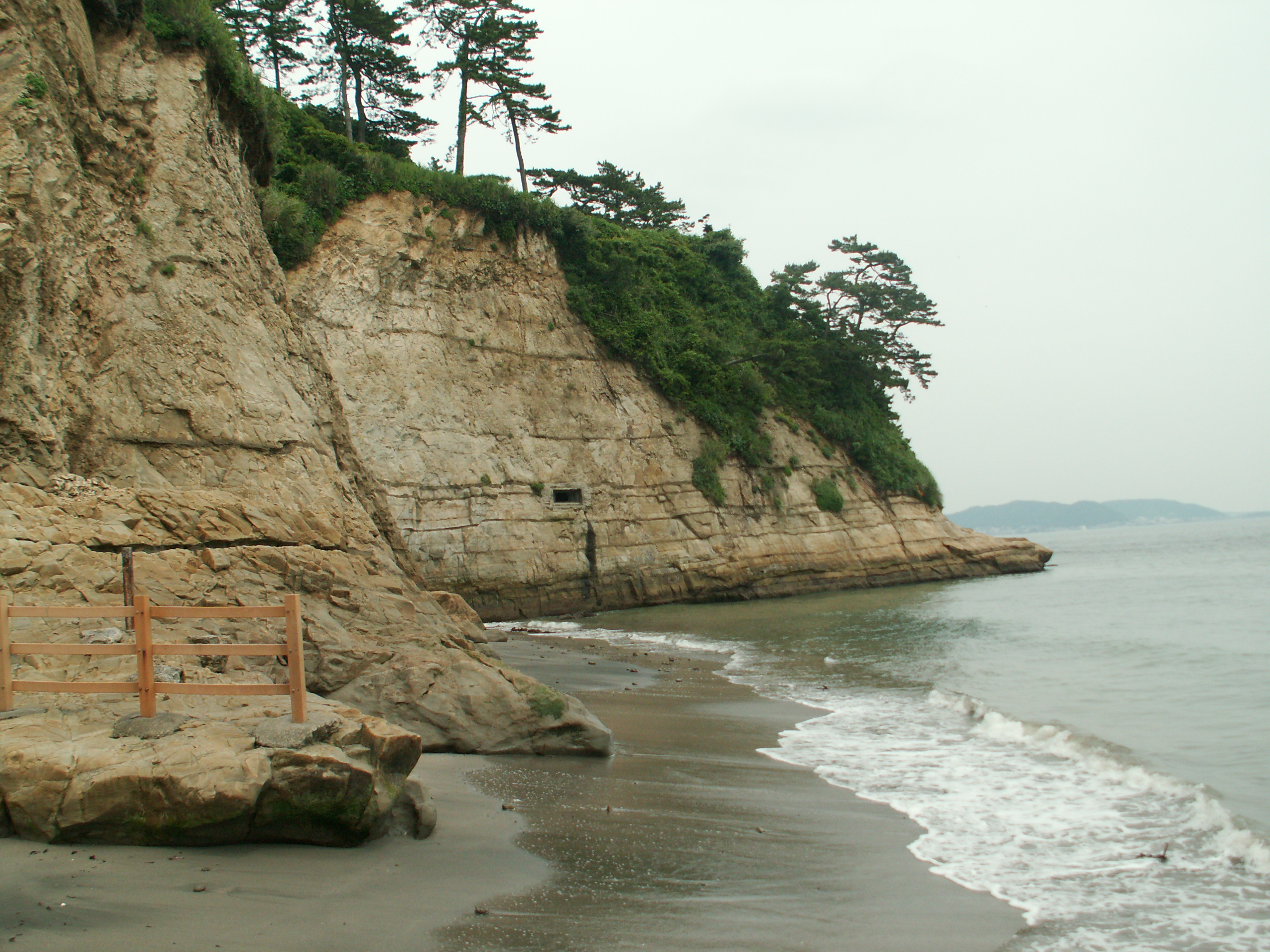Inamuragasaki Tottanbu on:
[Wikipedia]
[Google]
[Amazon]
 is a cape at the western end of
is a cape at the western end of
 Because the ancient Tōkaidō highway passed along the sea south of this cape before heading to the Miura Peninsula, before the opening of the Gokuraku Pass Inamuragasaki was the traditional point of entry to Kamakura at the time of the
Because the ancient Tōkaidō highway passed along the sea south of this cape before heading to the Miura Peninsula, before the opening of the Gokuraku Pass Inamuragasaki was the traditional point of entry to Kamakura at the time of the  Nitta's forces came down Kamakura Kaidō's northern course (the ), fighting the Hōjō along the way Arrived in Kamakura, they first tried to enter through the Gokuraku, Kobukorozaka and Kewaizaka Passes, but concentrated Hōjō forces managed to stop them. Judging it impossible to enter by land, Nitta decided to try bypassing Inamuragasaki.
Nitta's forces came down Kamakura Kaidō's northern course (the ), fighting the Hōjō along the way Arrived in Kamakura, they first tried to enter through the Gokuraku, Kobukorozaka and Kewaizaka Passes, but concentrated Hōjō forces managed to stop them. Judging it impossible to enter by land, Nitta decided to try bypassing Inamuragasaki.
稲村崎成干潟事
says (in Japanese):
Nengocalc
: ''June 30, 1333 (Genkō 3, 18th day of the 5th month)''
 It is believed that Nitta must have taken advantage of a low tide to enter Kamakura and capture it. Bypassing the cape on foot would be impossible today even at an extraordinarily low tide and its base is always entirely under water but, according to old texts, sea level there was lower a thousand years ago and a narrow strip of land regularly appeared at low tide. The Azuma Kagami states that, on September 21, 1181, ''
It is believed that Nitta must have taken advantage of a low tide to enter Kamakura and capture it. Bypassing the cape on foot would be impossible today even at an extraordinarily low tide and its base is always entirely under water but, according to old texts, sea level there was lower a thousand years ago and a narrow strip of land regularly appeared at low tide. The Azuma Kagami states that, on September 21, 1181, ''
 is a cape at the western end of
is a cape at the western end of Yuigahama
is a beach near Kamakura, a city in Kanagawa Prefecture, Japan. The relation between the beach and its neighboring areas is complex. Although Yuigahama is legally the entire 3.2 km beach that goes from Inamuragasaki, which separates it from ...
(Beach) in Kamakura
is a city in Kanagawa Prefecture, Japan.
Kamakura has an estimated population of 172,929 (1 September 2020) and a population density of 4,359 persons per km² over the total area of . Kamakura was designated as a city on 3 November 1939.
Kamak ...
, Kanagawa Prefecture
is a prefecture of Japan located in the Kantō region of Honshu. Kanagawa Prefecture is the second-most populous prefecture of Japan at 9,221,129 (1 April 2022) and third-densest at . Its geographic area of makes it fifth-smallest. Kana ...
, Japan
Japan ( ja, 日本, or , and formally , ''Nihonkoku'') is an island country in East Asia. It is situated in the northwest Pacific Ocean, and is bordered on the west by the Sea of Japan, while extending from the Sea of Okhotsk in the north ...
. The cape divides Yuigahama from Shichirigahama (Beach) and Enoshima. Its name seems to stem from its shape, similar to a stack of rice at harvest time (an ). At its foot on the Shichirigahama side there is a park, the .
History
 Because the ancient Tōkaidō highway passed along the sea south of this cape before heading to the Miura Peninsula, before the opening of the Gokuraku Pass Inamuragasaki was the traditional point of entry to Kamakura at the time of the
Because the ancient Tōkaidō highway passed along the sea south of this cape before heading to the Miura Peninsula, before the opening of the Gokuraku Pass Inamuragasaki was the traditional point of entry to Kamakura at the time of the Kamakura shogunate
The was the feudal military government of Japan during the Kamakura period from 1185 to 1333. Nussbaum, Louis-Frédéric. (2005)"''Kamakura-jidai''"in ''Japan Encyclopedia'', p. 459.
The Kamakura shogunate was established by Minamoto no Y ...
. Now crossed by a road (see photo), it used to be impassable by land and was therefore one of the natural defenses that made Kamakura an impregnable fortress.
For this reason, it appears often in the historical record. It is first mentioned in the Genpei Jōsuiki
The , is a 48-book extended version of the ''Heike Monogatari'' (''The Tale of the Heike'').
References
External links
at University of Virginia
The University of Virginia (UVA) is a Public university#United States, public research univ ...
because the Miura clan in 1180 crossed it twice to go rescue Minamoto no Yoritomo at the battle of Ishibashiyama
The was the first in which Minamoto no Yoritomo, who became ''shōgun'' less than a decade later, was commander of the Minamoto forces. The battle was fought on September 14, 1180, in the southwest of present-day Odawara, Kanagawa Prefecture, ...
. The troops didn't arrive in time, Yoritomo was defeated and the Miura had to go back the way they had come.
The cape then appears in the because its author in 1223 passed it to enter Kamakura. Inamuragasaki is also mentioned in the '' Azuma Kagami'', the ''Man'yōshū
The is the oldest extant collection of Japanese (poetry in Classical Japanese), compiled sometime after AD 759 during the Nara period. The anthology is one of the most revered of Japan's poetic compilations. The compiler, or the last in ...
'', the '' Heike Monogatari'' and the ''Taiheiki
The (Chronicle of Great Peace) is a Japanese historical epic (see ''gunki monogatari'') written in the late 14th century and covers the period from 1319 to 1367. Nussbaum, Louis-Frédéric. (2005)"''Taiheiki''"in ''Japan Encyclopedia'', pp. 923� ...
'', although the first two call it with its old name, .
Finally, Nitta Yoshisada made it immortal in Japanese culture bypassing it on the evening of July 3, 1333. to invade Kamakura, bringing the Kamakura shogunate
The was the feudal military government of Japan during the Kamakura period from 1185 to 1333. Nussbaum, Louis-Frédéric. (2005)"''Kamakura-jidai''"in ''Japan Encyclopedia'', p. 459.
The Kamakura shogunate was established by Minamoto no Y ...
to an end. For this reason, it has been nominated a Historic Site by the Japanese government.Kamiya vol. 1 (2008:236–238)
 Nitta's forces came down Kamakura Kaidō's northern course (the ), fighting the Hōjō along the way Arrived in Kamakura, they first tried to enter through the Gokuraku, Kobukorozaka and Kewaizaka Passes, but concentrated Hōjō forces managed to stop them. Judging it impossible to enter by land, Nitta decided to try bypassing Inamuragasaki.
Nitta's forces came down Kamakura Kaidō's northern course (the ), fighting the Hōjō along the way Arrived in Kamakura, they first tried to enter through the Gokuraku, Kobukorozaka and Kewaizaka Passes, but concentrated Hōjō forces managed to stop them. Judging it impossible to enter by land, Nitta decided to try bypassing Inamuragasaki.
The Taiheiki version of the events
According to the ''Taiheiki
The (Chronicle of Great Peace) is a Japanese historical epic (see ''gunki monogatari'') written in the late 14th century and covers the period from 1319 to 1367. Nussbaum, Louis-Frédéric. (2005)"''Taiheiki''"in ''Japan Encyclopedia'', pp. 923� ...
'', on the night before the attack Nitta watched from the top of a hill the enemy camp and its defenses closing the Gokuraku Pass, then the beach, blocked by heavy fortifications. He knew that the sea was guarded by hundreds of enemy ships. Looking at nearby Inamuragasaki, he threw his sword into the surf, prayed to RyūjinIn describing this event, Japanese sources say Nitta Yoshisada prayed to a sea-god or Ryūjin, English sources almost always refer to Sun Goddess Amaterasu. The Taiheiki itself稲村崎成干潟事
says (in Japanese):
Dismounting from his horse, Yoshisada removed his helmet and prostrating himself across the distant seas prayed to Ryūjin. "It is said that the lord of Japan from the beginning, Amaterasu Ōmikami, enshrined at Ise Jingū, hid herself within a Vairocana and appeared as Ryūjin of the vast blue seas. My lord (He therefore speaks to Ryūjin who, he has heard, is manifestation of Amaterasu. and asked for its help. The sea retreated by twenty ''chō'' (a mile), taking the Hōjō navy away and leaving ample space for his forces to penetrate. The stele at , the tiny bay west of Inamuragaki, says:Emperor Go-Daigo Emperor Go-Daigo (後醍醐天皇 ''Go-Daigo-tennō'') (26 November 1288 – 19 September 1339) was the 96th emperor of Japan, Imperial Household Agency (''Kunaichō'')後醍醐天皇 (96) retrieved 2013-8-28. according to the traditional order ...) is her descendant, and drifts upon waves of the western sea due to rebels. I Yoshisada, in an attempt to serve as a worthy subject, will pick up my axes and face the enemy line. That desire is to aid the nation and bring welfare to the masses. Ryūjin of the Eight Protectorate Gods of the (seven) Inner Seas and the Outer Sea, witness this subject’s loyalty and withdraw the waters afar, open a path to the lines of the three armies.
666 years ago on May 21, 1333 Nitta Yoshisada, judging an invasion on land to be difficult, decided to try to bypass this cape. This is the place where, according to tradition, he threw his golden sword into the waves, praying the sea-god to withdraw them and let him pass.In 1993, however, Japanese historian Susumu Ishii, after examining and comparing historical records and the results of recent surveys, declared that the date given by the Taiheiki must be wrong, and that the likely day of entry of Nitta's army must have been June 30, 1333.Gregorian date obtained directly from the original Nengō usin
(Stele erected in 1917)
Nengocalc
: ''June 30, 1333 (Genkō 3, 18th day of the 5th month)''
What historians believe happened
 It is believed that Nitta must have taken advantage of a low tide to enter Kamakura and capture it. Bypassing the cape on foot would be impossible today even at an extraordinarily low tide and its base is always entirely under water but, according to old texts, sea level there was lower a thousand years ago and a narrow strip of land regularly appeared at low tide. The Azuma Kagami states that, on September 21, 1181, ''
It is believed that Nitta must have taken advantage of a low tide to enter Kamakura and capture it. Bypassing the cape on foot would be impossible today even at an extraordinarily low tide and its base is always entirely under water but, according to old texts, sea level there was lower a thousand years ago and a narrow strip of land regularly appeared at low tide. The Azuma Kagami states that, on September 21, 1181, ''shōgun
, officially , was the title of the military dictators of Japan during most of the period spanning from 1185 to 1868. Nominally appointed by the Emperor, shoguns were usually the de facto rulers of the country, though during part of the Kamakur ...
'' Minamoto no Yoritomo went to Inamuragasaki because of an archery contest that was going to take place on its beach.Mutsu (1995:247)
Recent scientific surveys ''in situ'', taken into account present tide levels and estimated tide levels in 1333, confirm that Nitta's army could have entered Kamakura through Inamuragasaki exploiting a low tide. Since Nitta had spent a long time in Kamakura as a vassal of the Hōjō, he could have been familiar enough with its tides to be conceivably able to take advantage of them.
Notes
References
* * * {{Coord, 35, 18, 6, N, 139, 31, 32, E, region:JP_type:landmark_scale:1500, display=title Headlands of Japan Kamakura, Kanagawa Parks and gardens in Kanagawa Prefecture